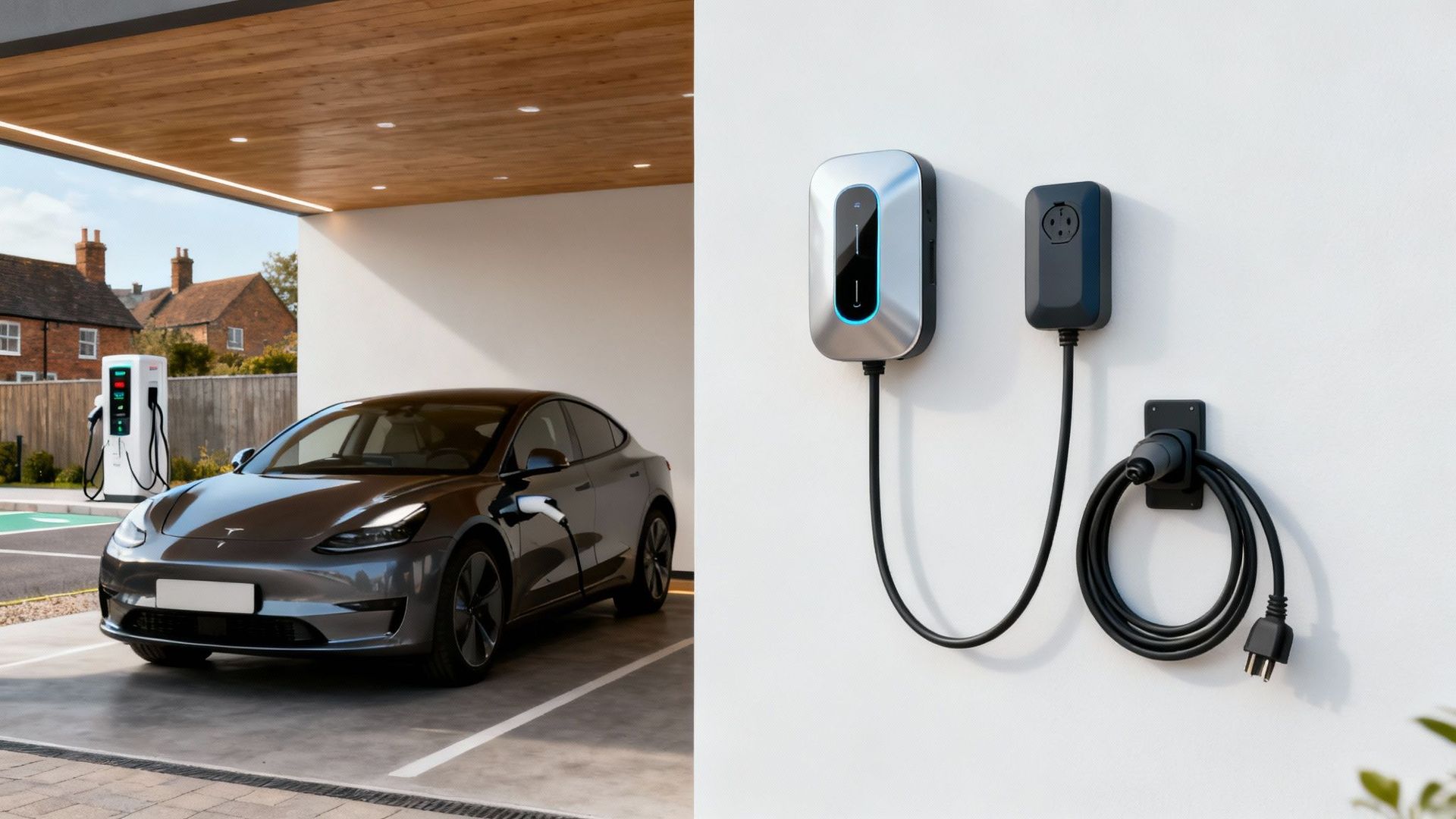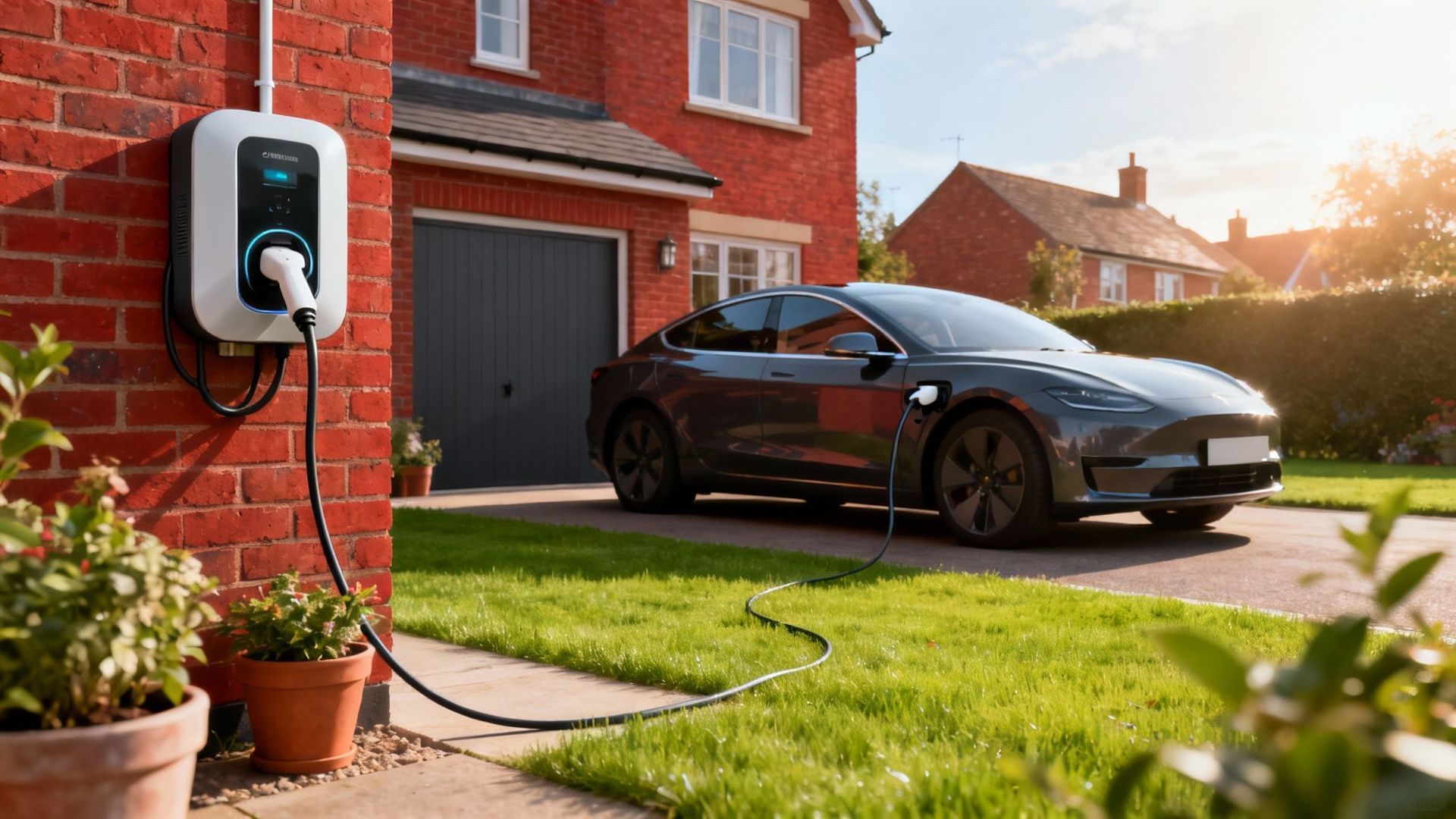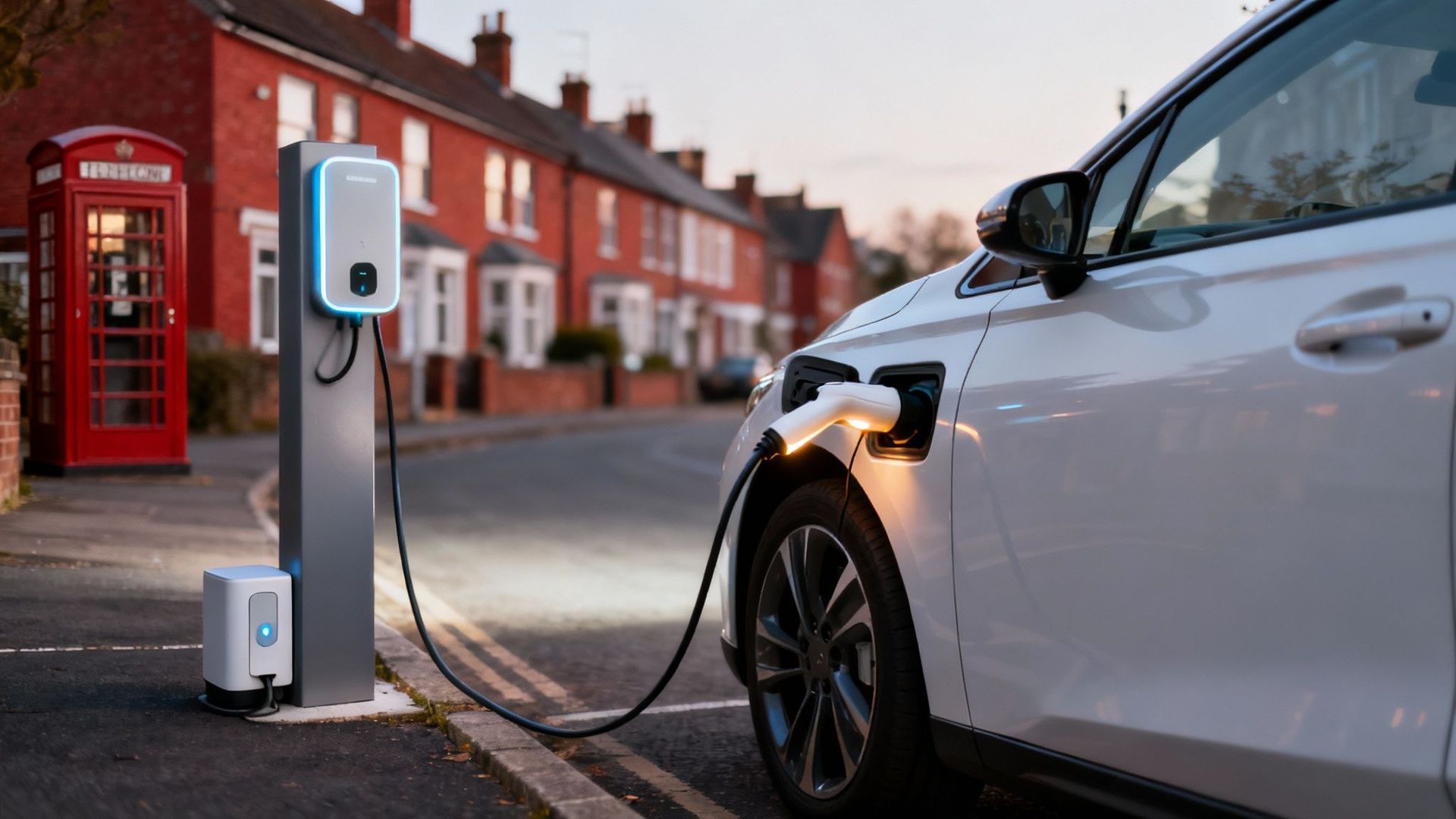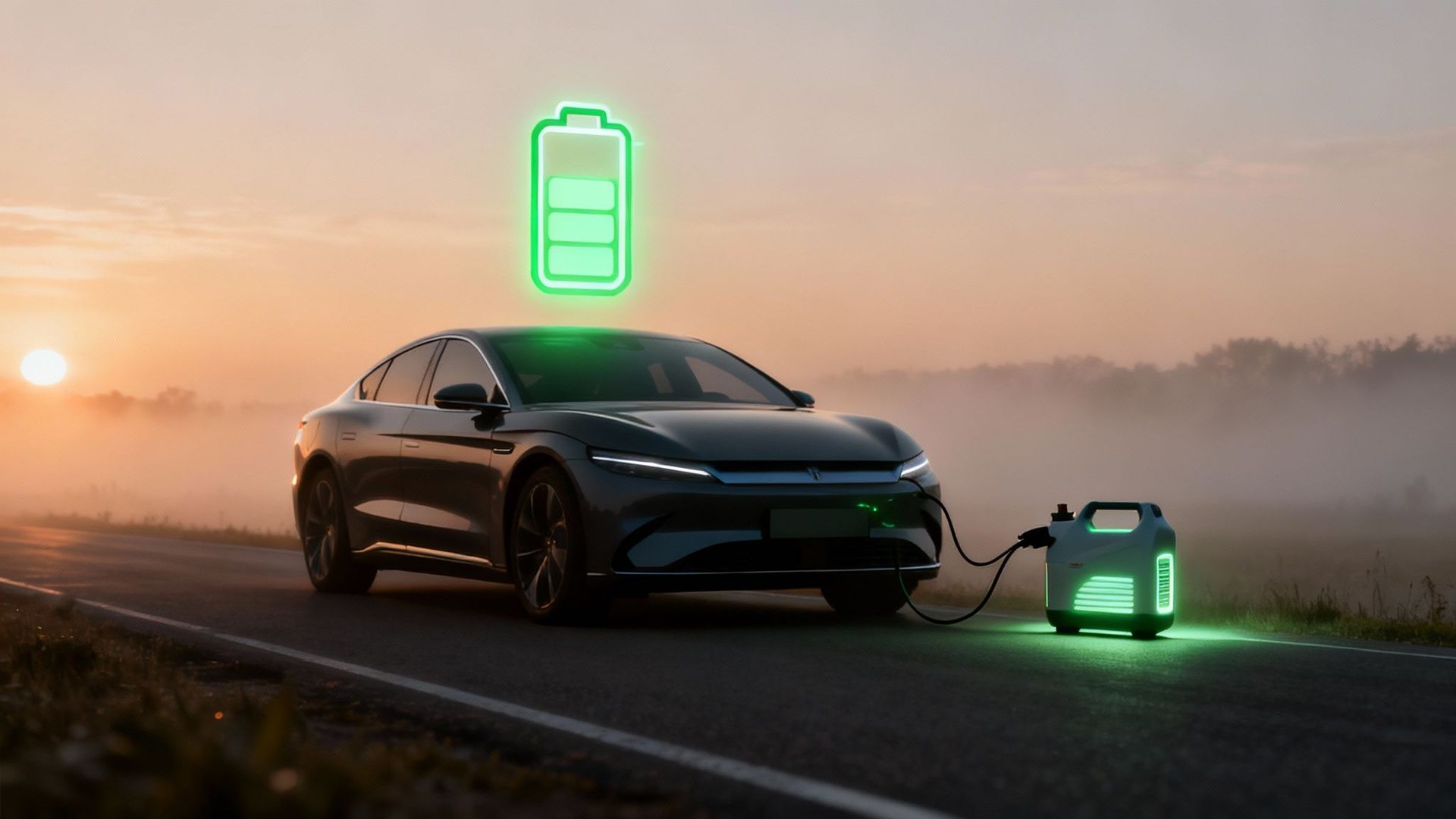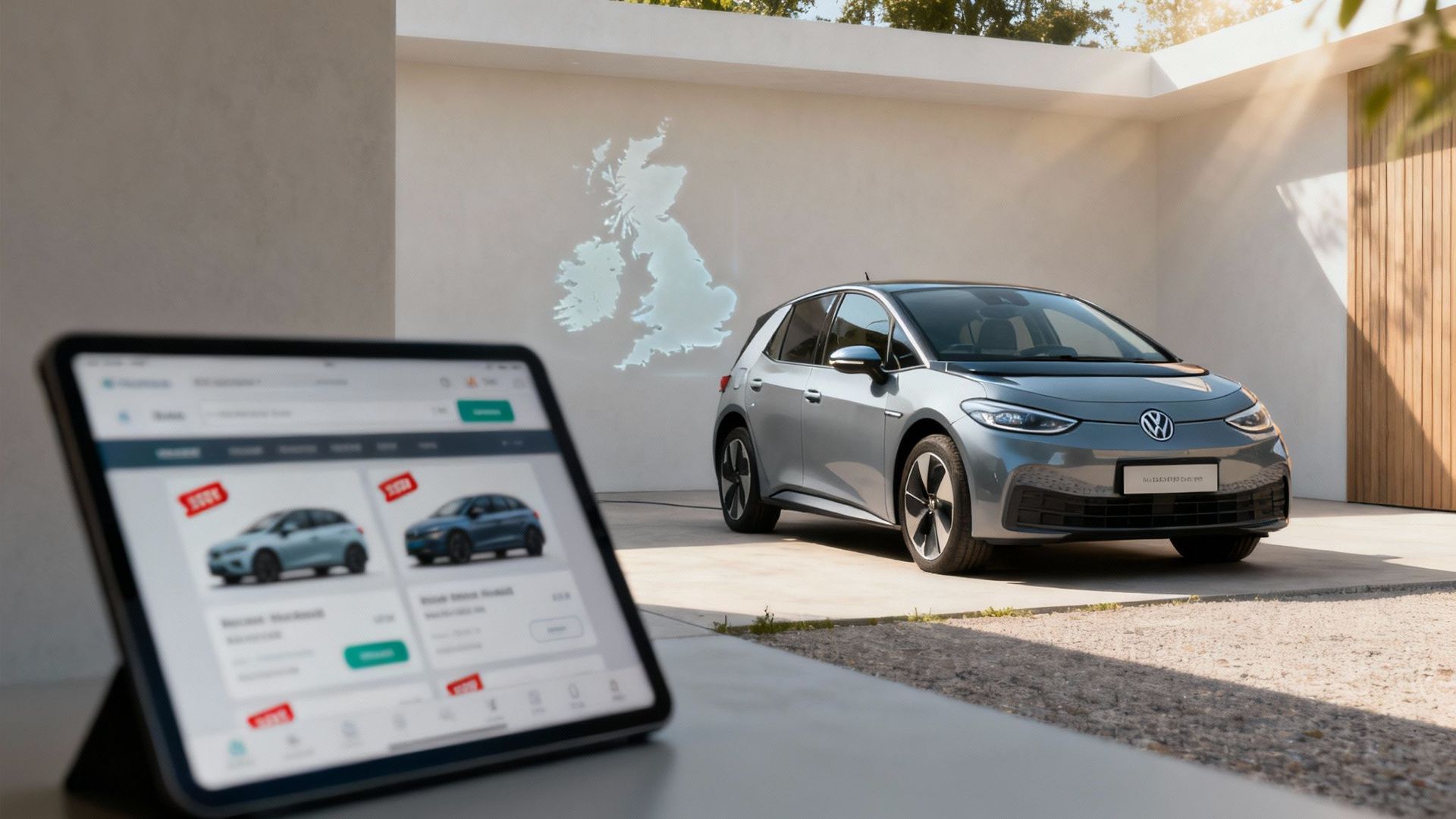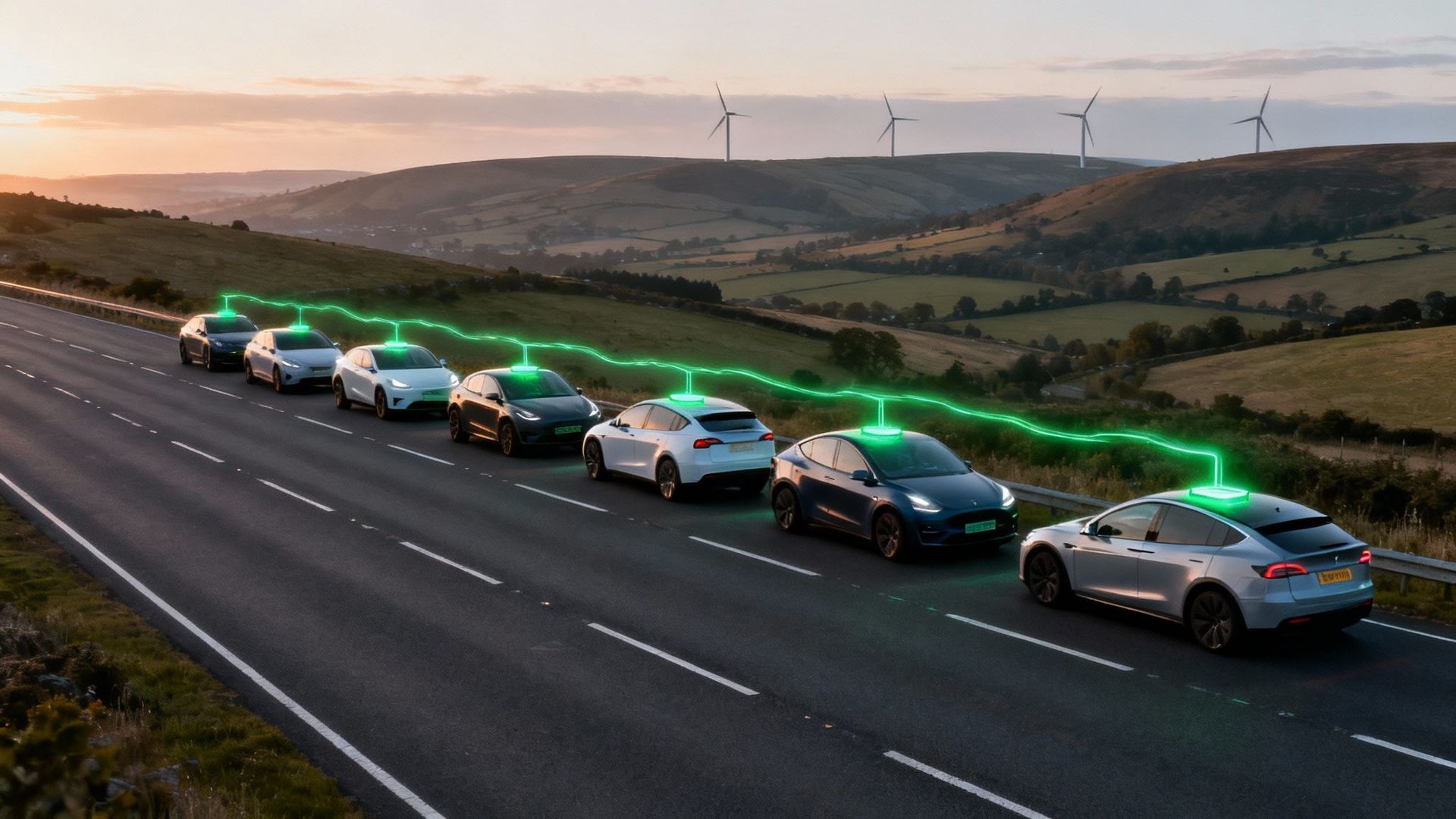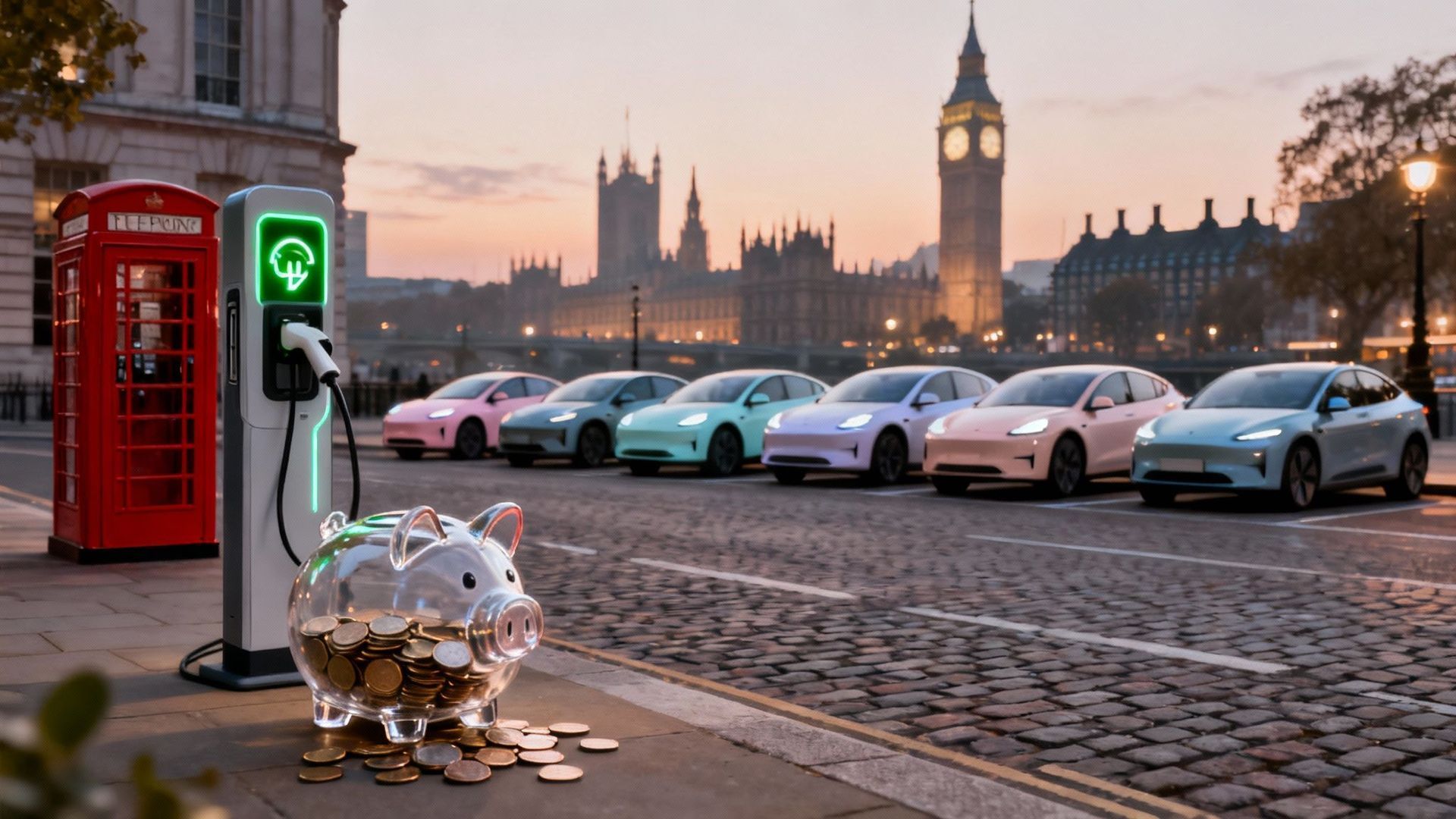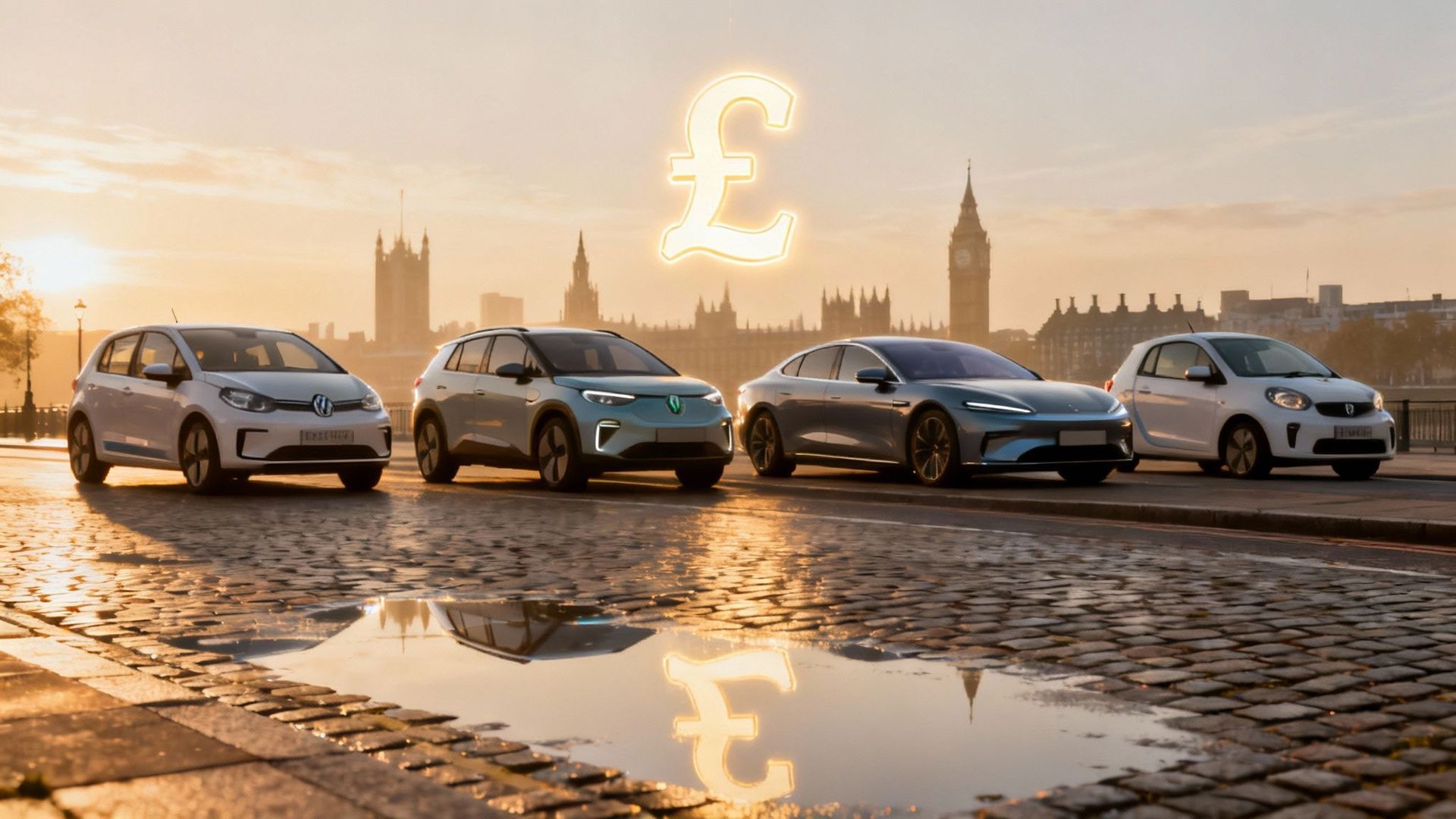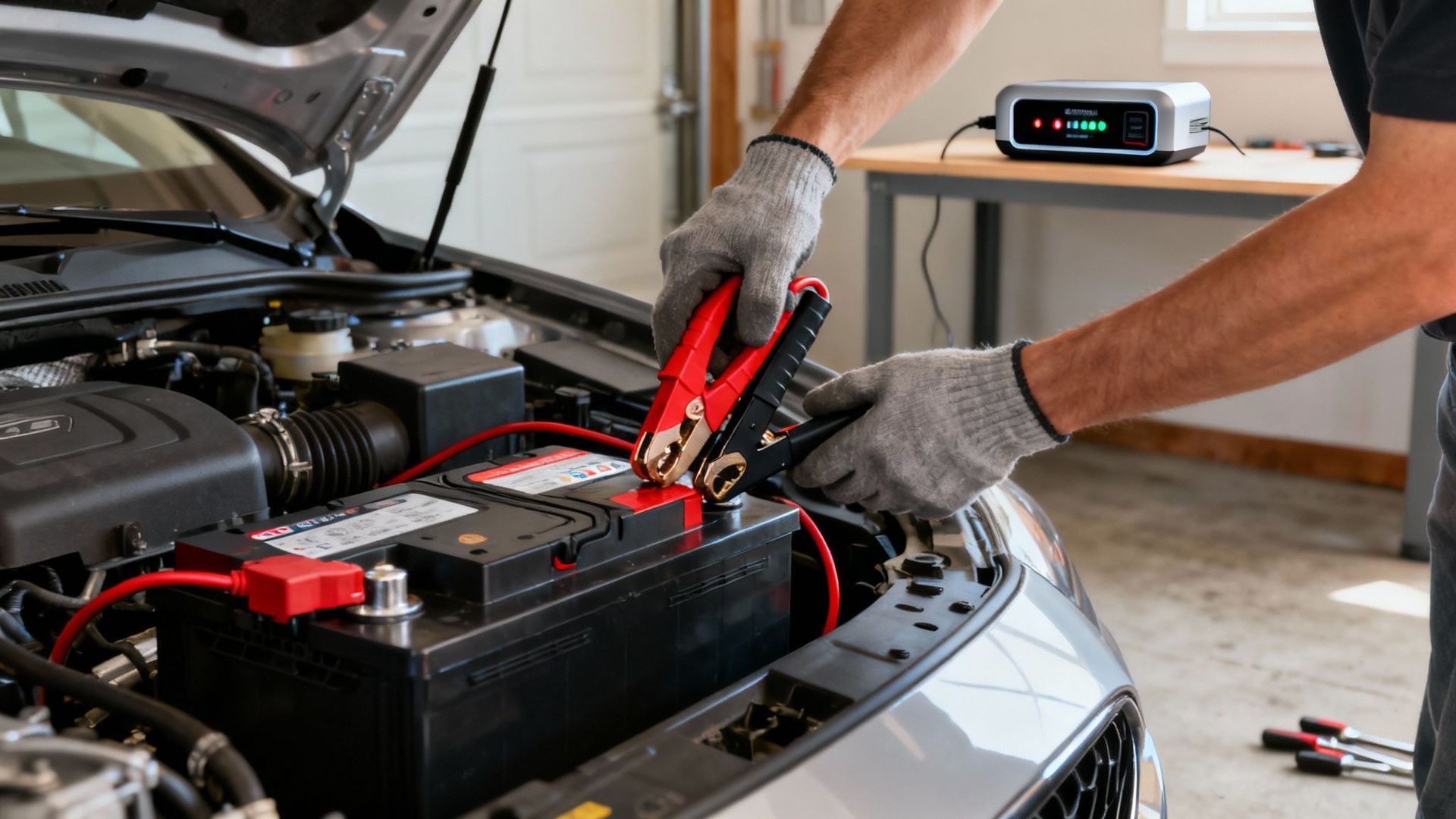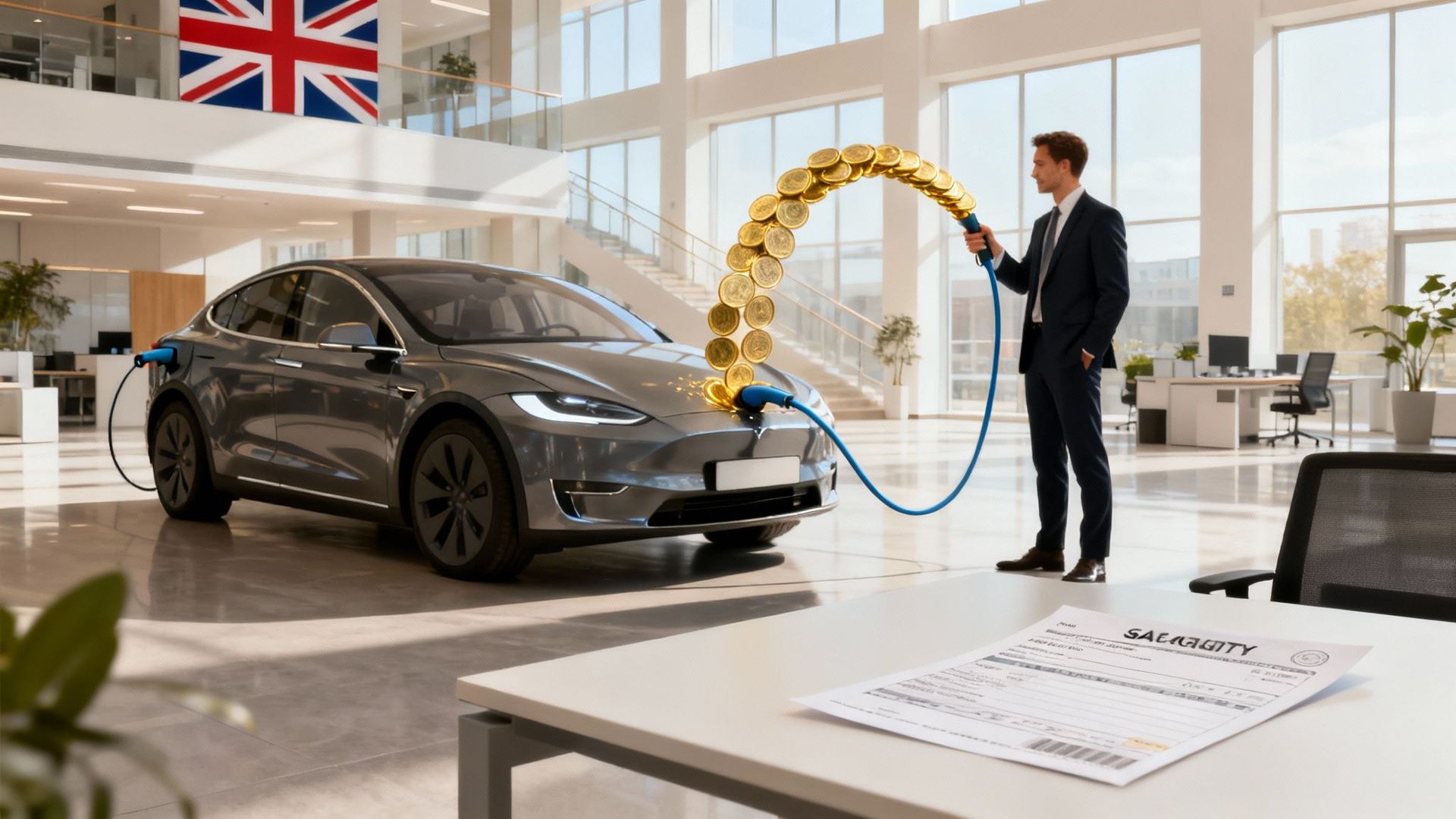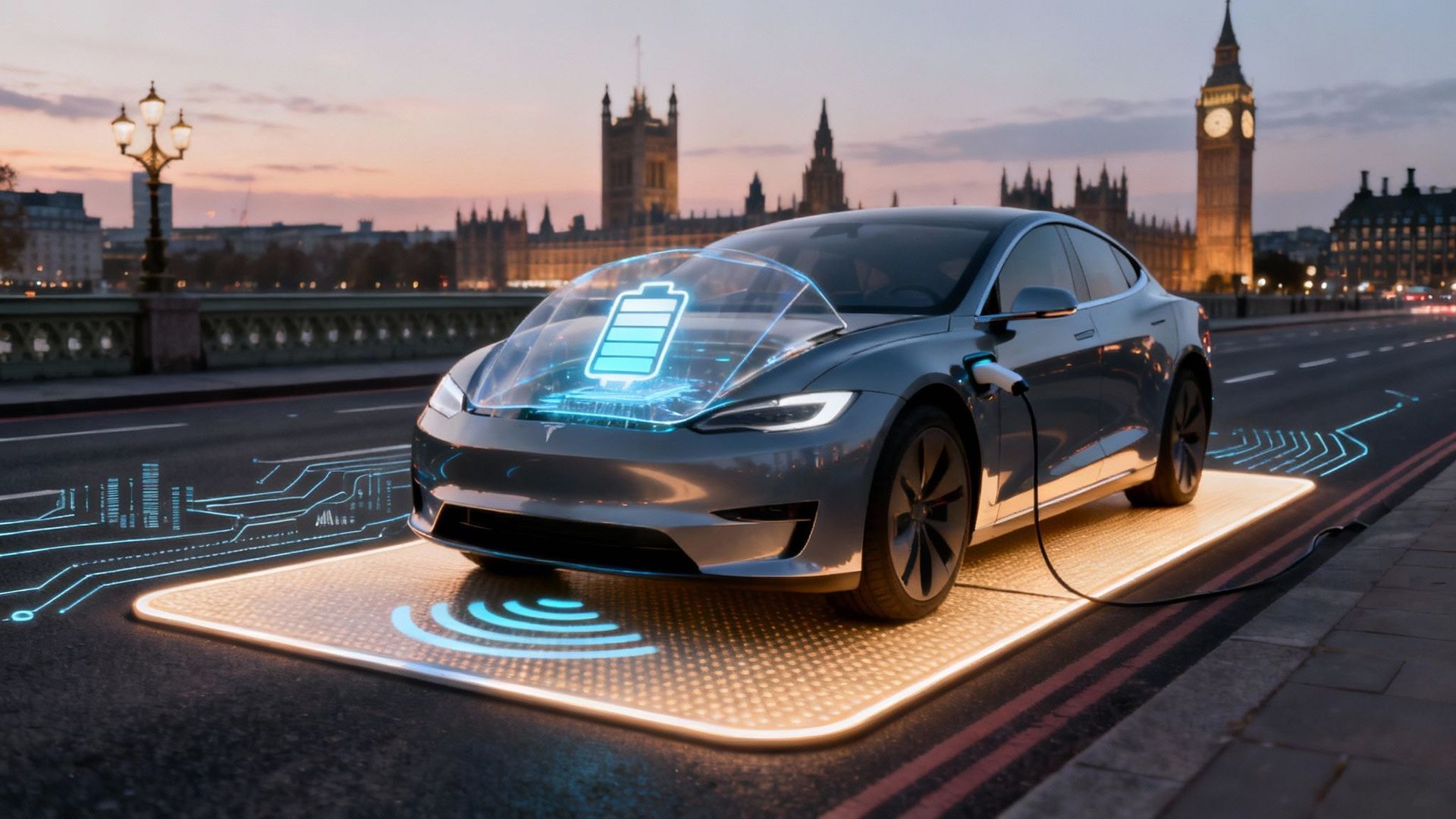UK EV Battery Replacement Cost: Prepare Your Wallet for a Pounding
Right then, let's cut the crap. The cost to replace an electric car battery in the UK can swing from a mildly terrifying £7,200 all the way up to a truly sphincter-clenching £36,000 . Yes, you read that correctly. For the price of swapping out your car's power pack, you could often buy another brand-new car. This potential expense is, without a doubt, the single biggest financial bogeyman lurking under the bed of many an EV owner.
The Shocking Price Tag on Your EV Battery

There's no point sugar-coating it: the thought of a full battery replacement is enough to give any EV driver a cold sweat. It's the unspoken dread in the showroom, the little detail that gets glossed over while you're being seduced by silent acceleration and zero tailpipe emissions.
The grim reality is, once your warranty buggers off, you could be facing a bill that makes a major service on a petrol car look like finding a fiver in your old jeans.
The cost spectrum is colossal, shifting dramatically based on which badge is on the front of your car. A new battery for a Nissan Leaf, for instance, could relieve you of between £14,000 and £16,500 . Meanwhile, a Tesla Model 3 Long Range might demand a sacrifice closer to £18,000 to £22,000 . This isn't just another repair; it's a "remortgage the house" kind of financial decision.
Estimated UK EV Battery Replacement Costs for Popular Models
To paint a clearer, if slightly more terrifying, picture, we've cobbled together a quick-glance table. It shows the potential out-of-warranty battery replacement costs for some of Britain's most common electric runabouts.
| Vehicle Model | Battery Size (kWh) | Estimated Replacement Cost (£) |
|---|---|---|
| Nissan Leaf | 40 kWh | £14,000 - £16,500 |
| Renault Zoe | 52 kWh | £8,000 - £11,000 |
| Tesla Model 3 Long Range | 75 kWh | £18,000 - £22,000 |
| Volkswagen ID.3 | 58 kWh | £15,000 - £18,000 |
| Tesla Model S | 100 kWh | £20,000 - £25,000+ |
Remember, these are just ballpark figures to scare you with. The final invoice will always depend on the specific vehicle, labour rates, and whether you're daft enough to opt for a brand-new unit instead of a refurbished one.
The cost of an EV battery isn't just about the cells inside. It's a ridiculously complex piece of kit, combining the battery pack, sophisticated cooling systems, and clever-clogs management software into one wallet-molesting unit.
This potential outlay is a critical piece of the puzzle when calculating your total running costs. It’s a huge factor to consider when evaluating the real cost of owning an EV compared to petrol cars. While you'll save a fortune on fuel and road tax, one major component failure out of warranty could wipe out years of those savings in an instant.
The point isn't to put you off switching to electric. It’s about marching into ownership with your eyes wide open, armed with the cold, hard numbers you need to know.
Why Your EV Battery Costs a King's Ransom

Right, so you’ve seen the numbers that would make a lottery winner flinch and are probably wondering why on earth an EV battery costs so much. It’s a fair question. The short answer is that it's not just a big box of Duracells; it's an incredibly complex and resource-intensive bit of engineering wizardry.
The main culprit behind the sky-high price tag is the raw materials. Your EV battery is packed with exotic metals like lithium, cobalt, nickel, and manganese , all of which have to be dug out of the ground, processed, and shipped halfway around the world.
The prices for these materials are notoriously volatile. A supply chain hiccup or a bit of political argy-bargy on the other side of the planet can directly add thousands of pounds to your future EV battery replacement cost .
More Than Just Minerals
Beyond the precious metals, the battery pack itself is a modern marvel. It’s not one single lump but a sophisticated assembly of thousands of individual cells, all carefully arranged into modules. These are then housed in a protective case complete with complex cooling systems and a dedicated computer—the Battery Management System (BMS)—that's a bit like a tiny, neurotic accountant constantly monitoring the health of every single cell.
This intricate design means a failure isn't as simple as swapping out a duff part. It’s more like performing open-heart surgery on a landmine. This complexity leads to eye-watering labour charges, as only highly trained technicians with the right gear can safely handle the job. They aren’t just unbolting something; they’re dealing with a component that can weigh as much as a small car and holds enough energy to power your house for days.
Think of it this way: you're not just paying for a battery. You're paying for the global mining operation, the high-tech factory that assembled it, the software that runs it, and the specialist technician who needs a bomb-disposal suit just to look at it sideways.
The All-Important Cost Per Kilowatt-Hour
To really get your head around the final bill, you need to understand a key industry metric: cost per kilowatt-hour (£/kWh) . This figure represents the price for each unit of energy capacity the battery can hold. While this number has been tumbling over the years, it still has a huge impact on the overall cost.
In the UK, the average cost per kilowatt-hour for a replacement battery pack hovers around £109.25 . This directly translates into massive bills for cars with large batteries. For example, a hefty pack like the one in a Kia EV6 can easily command a replacement price between £20,000 and £25,000 . You can see a full breakdown of how battery size and damage influence these figures here.
Ultimately, a bigger battery means more range, but it also means a much, much bigger bill when it finally shuffles off this mortal coil.
Understanding Your EV Battery Warranty

Before you have a full-blown panic attack about a potential EV battery replacement cost , let’s talk about your most important safety net: the manufacturer's warranty. For most EV drivers, this often-ignored bit of paper is the only thing standing between them and a bill that could make your eyes water.
Think of it as your get-out-of-jail-free card if your battery carks it prematurely. It’s designed to protect you from those nightmare scenarios you hear about on the internet. But like any legal document, the devil is in the detail, and it pays to know exactly what you’re covered for.
What Does the Warranty Actually Cover?
An EV battery warranty is there to cover two main things: a complete, catastrophic failure (which is mercifully rare) and excessive battery degradation . It's this second point that's most relevant for owners.
Degradation is just the natural, gradual loss of a battery's ability to hold a full charge over time. It happens to all batteries, from your phone to your car. Think of it like your favourite pair of jeans – they still work, but after years of wear and washing, they might be a bit stretched and faded.
Manufacturers know this is inevitable, so they set a specific health threshold. If your battery’s capacity drops below this magic number while still under warranty, they are obliged to sort it out – either through repair or a full replacement, completely free of charge. This is your shield against that five-figure invoice.
A warranty claim isn't triggered by a minor dip in your range. To qualify for a free replacement, the battery's State of Health (SOH) typically has to fall below 70-80% of its original capacity within the warranty's time and mileage limits.
Comparing the Fine Print
Of course, not all warranties are created equal. While most carmakers have settled on a fairly similar baseline, the specifics can and do vary between brands and even models.
The industry standard in the UK has become eight years or 100,000 miles , whichever comes first. This gives the first owner, and often the second, a solid period of protection during the most critical part of the battery’s life.
Here’s a quick rundown of what some of the big names offer:
- Tesla: Provides an 8-year warranty, but the mileage cap changes by model – from 100,000 to 150,000 miles. They all guarantee at least 70% battery capacity retention.
- Volkswagen (ID. models): Sticks to the standard 8-year or 100,000-mile warranty, also with a 70% capacity guarantee.
- Hyundai/Kia: Are well-known for their strong warranties, typically covering 8 years or 100,000 miles and promising to maintain that same 70% health threshold.
Getting to grips with these terms before you buy an EV is crucial. Knowing your policy’s exact limits and conditions is your best defence against a future financial shock. Policies are always changing, so it's worth reading up on the future of EV warranties and what it means for buyers to stay informed. When in doubt, always check the specific paperwork for your car.
OEM vs Third-Party Battery Replacements
So, your warranty has expired, and your EV's battery is starting to feel less like a powerhouse and more, well, pathetic. You’re now at a familiar fork in the road for any car owner: do you trudge back to the main dealer for an official, and often shockingly expensive, Original Equipment Manufacturer (OEM) battery? Or do you take a punt on the growing world of independent specialists for a third-party solution?
It's a classic head-versus-heart (or rather, wallet) dilemma. Sticking with an OEM replacement is the safe bet, even if it makes your bank account weep. You're guaranteed a brand-new or factory-refurbished battery pack that’s a perfect match for your car, fitted by technicians who know the vehicle inside and out. Plus, the manufacturer's warranty on the part itself adds a comforting layer of security.
On the flip side, the third-party market is becoming a really compelling alternative. Independent garages and battery specialists can often source used or refurbished packs from other vehicles. Some can even perform "surgery" on your existing battery, replacing only the faulty modules. This is where the real savings are made, often cutting the cost dramatically.
This chart breaks down just how much you could save by looking beyond a brand-new, dealer-supplied battery.
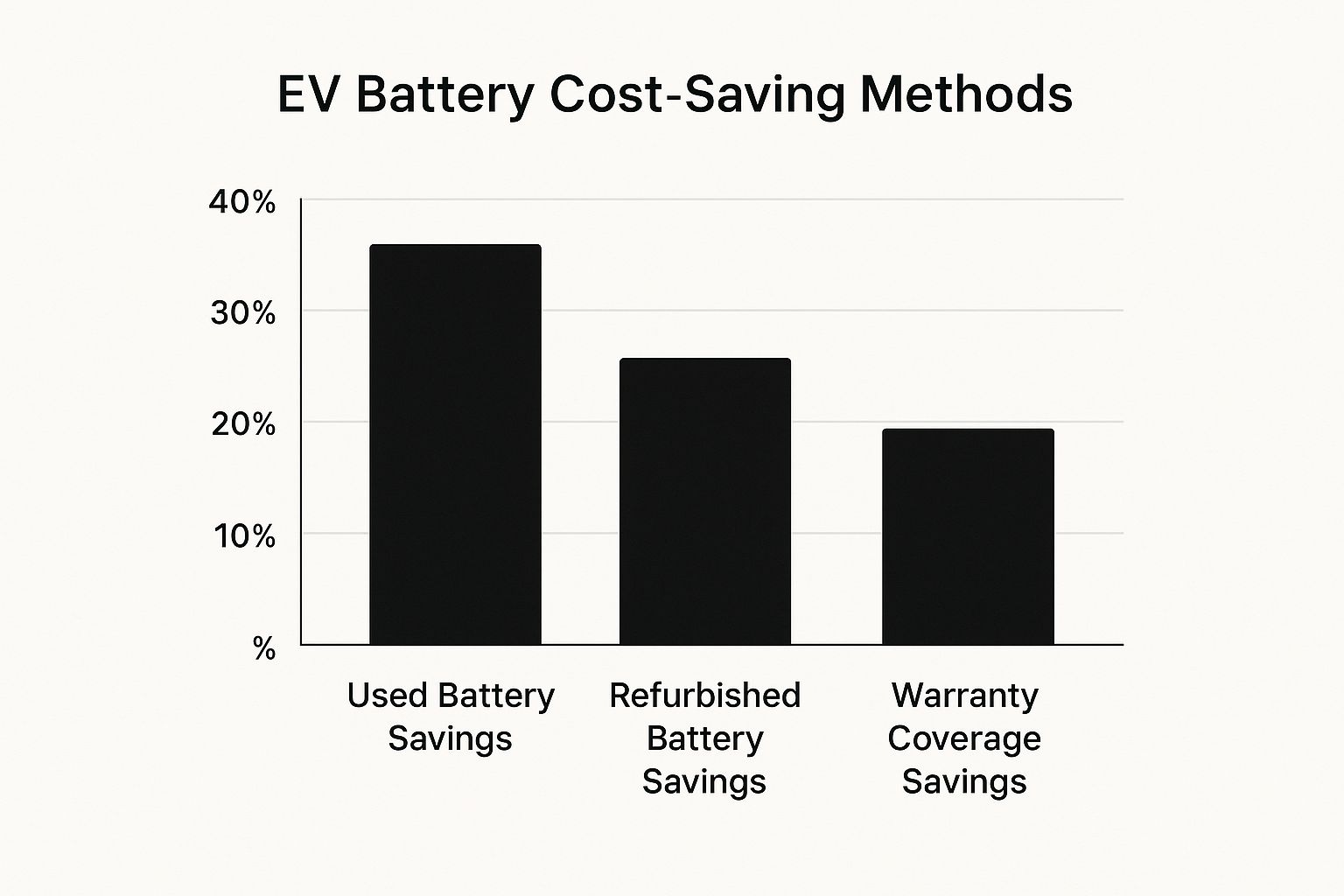
As you can see, opting for a used battery from a trusted independent specialist could potentially slash your final bill by up to 40% compared to buying new from a dealer.
OEM vs Third-Party Battery Replacement: The Great Debate
Deciding between the main dealer and an independent specialist isn't straightforward. Each route has clear pros and cons that you need to weigh up against your budget and how much risk you're comfortable with.
Here’s a head-to-head comparison to help you decide.
| Factor | OEM (Main Dealer) | Third-Party (Independent Specialist) |
|---|---|---|
| Cost | Highest cost. You pay a premium for the brand and guarantee. | Significantly lower. Potential for 30-50% savings through used or repaired parts. |
| Part Quality | Guaranteed new or manufacturer-refurbished parts. | Variable. Can range from excellent refurbished modules to questionable used parts. |
| Compatibility | Guaranteed. The part is designed specifically for your vehicle. | A potential risk. Improperly matched or coded batteries can cause software issues. |
| Warranty | Comes with a manufacturer-backed parts and labour warranty. | Varies wildly. Can range from a comprehensive 12-month warranty to just 90 days. |
| Expertise | Technicians are trained specifically on your make and model. | Specialist knowledge can be exceptional, but quality varies between garages. |
| Resale Value | A full dealer service history with an OEM replacement maintains higher resale value. | May negatively impact resale value, especially without detailed paperwork. |
Ultimately, there's a trade-off. Going to the main dealer buys you peace of mind at a premium, while a good independent can offer fantastic value if you do your homework and find a reputable one.
The Risks of Going Rogue
Of course, stepping away from the main dealer network isn’t without its pitfalls. The quality of third-party work can be a lottery; for every highly-skilled specialist, there's a chancer learning on the job with your very expensive car.
Compatibility is another potential headache. An EV battery isn't just a box of power; it's intricately linked to the car's software. A poorly matched pack can trigger a cascade of electronic gremlins or, in a worst-case scenario, not work at all.
"Choosing a third-party repairer is a calculated gamble. You're betting their expertise and lower overheads will save you thousands, but you're also accepting the risk of dodgy parts and potential compatibility issues that could bite you later on."
Finally, think about your car's future resale value. A vehicle with an official OEM battery, backed up by paperwork from a main dealer, is a much more appealing prospect for a potential buyer than one with a mystery battery fitted by a lesser-known garage.
The decision really comes down to your budget versus your appetite for risk. Do you play it safe and pay the premium, or do you roll the dice for a chance at saving thousands?
How to Extend Your Battery's Lifespan
Let's be honest, the best way to handle a monumental EV battery replacement cost is to put it off for as long as humanly possible. The secret isn't some complex maintenance schedule; it’s all about treating your battery with a bit of mechanical sympathy.
Think of it less like a smartphone you can run down to zero and more like a crucial part of your car that rewards good habits. A few small tweaks to how you charge and drive can add years to its life, pushing that scary five-figure bill so far into the future you might never have to face it.
The Golden Rules of Charging
How you charge your car day-to-day has the single biggest impact on your battery's long-term health. It's tempting to blast it on a rapid charger every time, but that's like living on a diet of energy drinks and regret – you get a quick boost, but it’s not doing you any good in the long run.
Rapid DC chargers are lifesavers on a long schlep up the M1, but they put a lot of strain on the battery cells. For your daily top-ups, a slower, gentler charge from a home wallbox is always the better choice. This steady trickle of power is much kinder to the battery's internal chemistry, dramatically slowing down its inevitable degradation.
If you take away just one tip, make it this: try to keep your battery's charge between 20% and 80% for daily use. Constantly charging to 100% or letting it drain completely flat puts the cells under unnecessary stress. Sticking to the 20-80% window gives the battery a comfortable buffer, which is a cornerstone of long-term health.
Driving Style and The Great British Weather
Your driving style also makes a bigger difference than you might think. Launching away from every set of traffic lights like you're on the starting grid at Silverstone is a sure-fire way to accelerate battery wear. This kind of aggressive driving forces the battery to discharge huge amounts of energy quickly, generating heat – the number one enemy of battery longevity.
Smooth, gentle acceleration and braking are your best friends. It’s not just more efficient; it's far less stressful for the entire system. And then there's our famously unpredictable British weather. Extreme cold can temporarily sap your range, but it's the summer heatwaves that do the real damage, speeding up the chemical reactions that cause degradation. If you can, park in the shade or a garage on scorching hot days.
To get a fuller picture of what to expect, you can learn more about how long EV batteries really last and all the different factors that play a part.
The Future of EV Battery Costs in the UK
After all that doom and gloom about five-figure repair bills, let’s end on a more optimistic note. While the current EV battery replacement cost is steep enough to make anyone nervous, the good news is that this financial sting isn’t set to last. The entire industry is racing towards a future where EV batteries become genuinely affordable.
This isn’t just wishful thinking; it’s a trend backed by some serious innovation. Scientists and engineers are constantly refining battery chemistry, finding cheaper and more abundant materials to replace costly and ethically tricky metals like cobalt. We're also seeing the rise of new designs, like the much-talked-about solid-state batteries, which promise not just better performance but also simpler, cheaper manufacturing.
Think of it like the journey of the flat-screen TV. Remember when a 42-inch plasma screen cost more than a used car? Now you can grab a massive, high-spec one for a few hundred quid. Battery technology is on a very similar path, and the pace of change is accelerating.
The Downward Price Spiral
It's not just boffins in labs driving prices down; global economics are playing a huge role too. As supply chains for raw materials mature and battery recycling becomes more efficient, the cost of the core ingredients is set to drop.
The long-term outlook is genuinely bright for the UK driver's wallet. While today's replacement costs are a major concern, the evidence points towards a much more manageable financial future for EV ownership.
This trend is already showing up in global forecasts. Some predictions suggest average battery prices could fall to around $80/kWh in the coming years – a drop of nearly 50% from recent highs. This dramatic slide is a direct result of smarter tech and falling prices for key metals. You can explore the insights on declining battery prices from Goldman Sachs to see the full analysis.
For the average UK driver, this all translates into a simple, welcome reality: the single most expensive part of their car is getting cheaper every year. It won’t happen overnight, but the era of the terrifyingly expensive battery replacement is, thankfully, on its way out.
EV Battery Questions: Your Queries Answered
Still have a few questions buzzing around about EV batteries? It’s a complex topic, so that’s completely understandable. Let's get them answered.
Can I Just Replace One Faulty Module in My EV Battery?
In many cases, yes, you absolutely can. Think of it like fixing a single dodgy cell in a torch battery pack instead of binning the whole thing. If a diagnostic check can isolate the problem to a specific module, a skilled independent garage can often perform this bit of 'keyhole surgery'.
This is a brilliant way to save a small fortune. You could be looking at a bill between £1,000 and £3,000 , which is a far cry from the cost of a complete new battery pack. It all depends on your car’s design, though—some battery packs are built to be easily serviceable, while others are sealed up tighter than a drum.
Will My Car Insurance Cover the Cost of a New Battery?
When it comes to the battery simply getting old and tired, that’s a firm no. Your car insurance is designed to cover sudden, unexpected events, not the gradual and inevitable process of wear and tear.
However, if your battery gets damaged in a collision, is submerged in a flood, or is involved in a fire, then your comprehensive policy should cover the replacement. But for the natural decline in performance over time, you’ll be footing the bill yourself once the manufacturer’s warranty has run its course.
Insurance policies are for accidents and unforeseen damage. They treat battery degradation like any other consumable part, such as brake pads or tyres – it's considered a maintenance cost, not an insurable event.
What Happens to Old EV Batteries When They're Replaced?
They certainly don't end up in a landfill, thankfully. Old EV batteries are packed with valuable materials and are given a new lease on life.
Many are repurposed for what’s known as ‘second-life’ applications. They might not have the grunt for a car anymore, but they’re perfect for things like home energy storage systems, quietly powering your house for another decade. The rest are sent to specialised recycling plants where crucial materials like lithium, cobalt, and nickel are carefully extracted to build the next generation of batteries, closing the loop and making the whole process more sustainable.
At VoltsMonster , we cut through the jargon to give you the real story on EVs. For more honest reviews and guides, check out our latest articles at https://www.voltsmonster.com.

